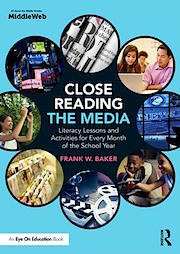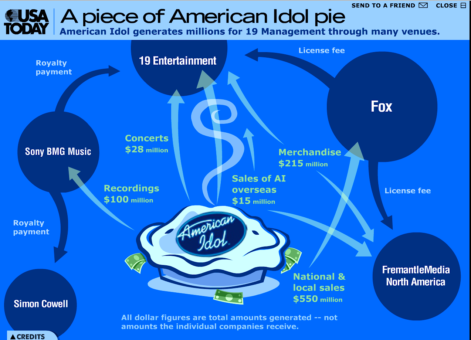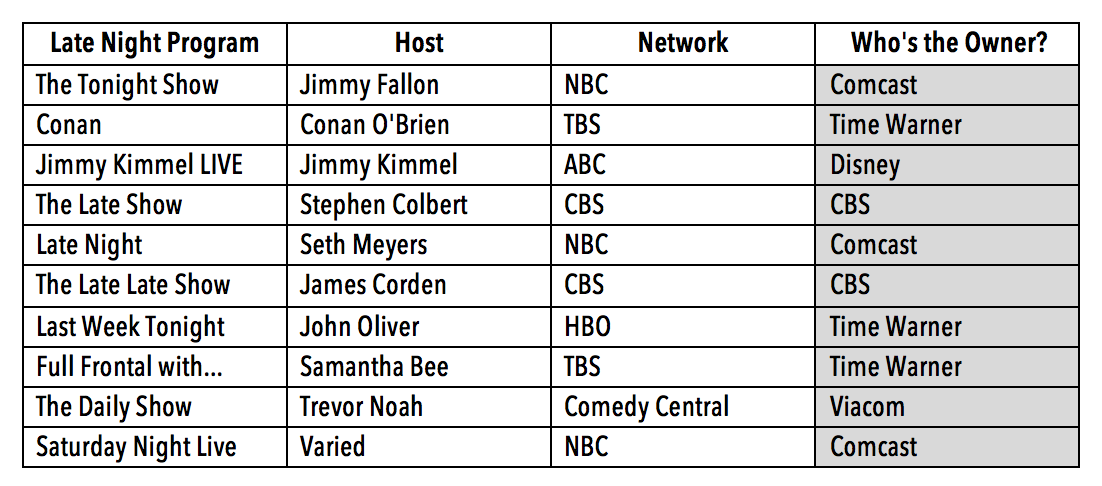How Big Media Shapes the News Students See
In the fall of 2016, AT&T announced its intention to purchase Time Warner Cable. Many were surprised and some asked: why would a technology company want to buy a cable TV company? Consumer groups also expressed some worry: would the merged company offer more or less options; would prices for cable and programming increase?
For some, the worry was heightened by AT&T’s previous purchase of the DirecTV satellite network in 2014. Yet in a December congressional hearing, AT&T CEO Randall Stephenson assured senators that the new merger “wouldn’t be consequential to consumers.”
Sen. Amy Klobuchar (D-Minn.) responded that any decision by the mergered corporation that resulted in less competition would affect consumers directly, giving them “less options to choose internet, streaming and cable providers, leading to massive fluctuations in subscription costs across the board.”
(Stay tuned because this $85.4 billion merger has not been approved and will continue to be in the news in 2017.)
Big Media is Big Business
Every form of media needs money to stay in business. Rarely in American schools do students study the business of the media, but it’s important. Pick up a magazine and ask yourself: how does the media make money? That favorite TV show you love to watch every week – do you know how it got on the air? What about the internet site that feeds teenagers a customized brand of news?
The answer, of course, is advertising. Advertising is the force behind all media, including social media. It pays for the magazines you love and the TV shows you can’t live without. Look at the following sentence:
This program is brought to you by our sponsors.
Most of us have heard a similar statement sometime in our lives. But let me challenge you and your students to move the words in this sentence around and come up with a new sentence that would more accurately define the relationship between television, advertisers and audiences.
If you’re stumped, let me help:
You are brought to our sponsors by this program.
If you incorporate this word-swapping into a lesson, let the reality sink in for a moment with your students. Yes, we are all being “delivered” to the advertisers by the program itself. Remember, it’s called commercial television. And if the program doesn’t deliver enough of us to the advertisers, it will be cancelled. (See my earlier MiddleWeb post: “Your Students’ Eyeballs Are Worth a Bundle.”)
American Idol, a popular reality TV competition, premiered on the FOX Network during the summer of 2002. How did it get on the air? The producers of American Idol had to first identify who was most likely to want to watch this weekly program (the demographic). When they figured that out, they knew they’d go after advertisers who valued that same audience.
They then made a pitch to those advertisers, who gather each year at the annual “upfronts,” a TV marketplace for networks, programmers and advertisers. Once they signed enough advertisers, they could begin producing and broadcasting the program (and raking in income from those ads).
In the case of American Idol, the commercial bonanza didn’t stop there. Thanks to its huge success and high marketability, it became a brand, making millions through spinoff concerts, clothes, music CDs and much, much more. Take a look at this infographic from the USA Today newspaper:
Source: Carey, Anne, and Jerry Moesmak. “A Piece of American Idol Pie.” USA Today. Gannett Co. Inc, 15 May 2005.
The Disney “Big Media” Example
Most of us are familiar with the Walt Disney Company theme parks in Florida and California. Disney also produces lots of television programs and movies. You may have heard of one of their recent films, Star Wars: The Force Awakens, which became the highest grossing film of all time in late 2015 and early 2016. But do you know what else Disney controls?
Take a look at this graphic from WIRED.com:
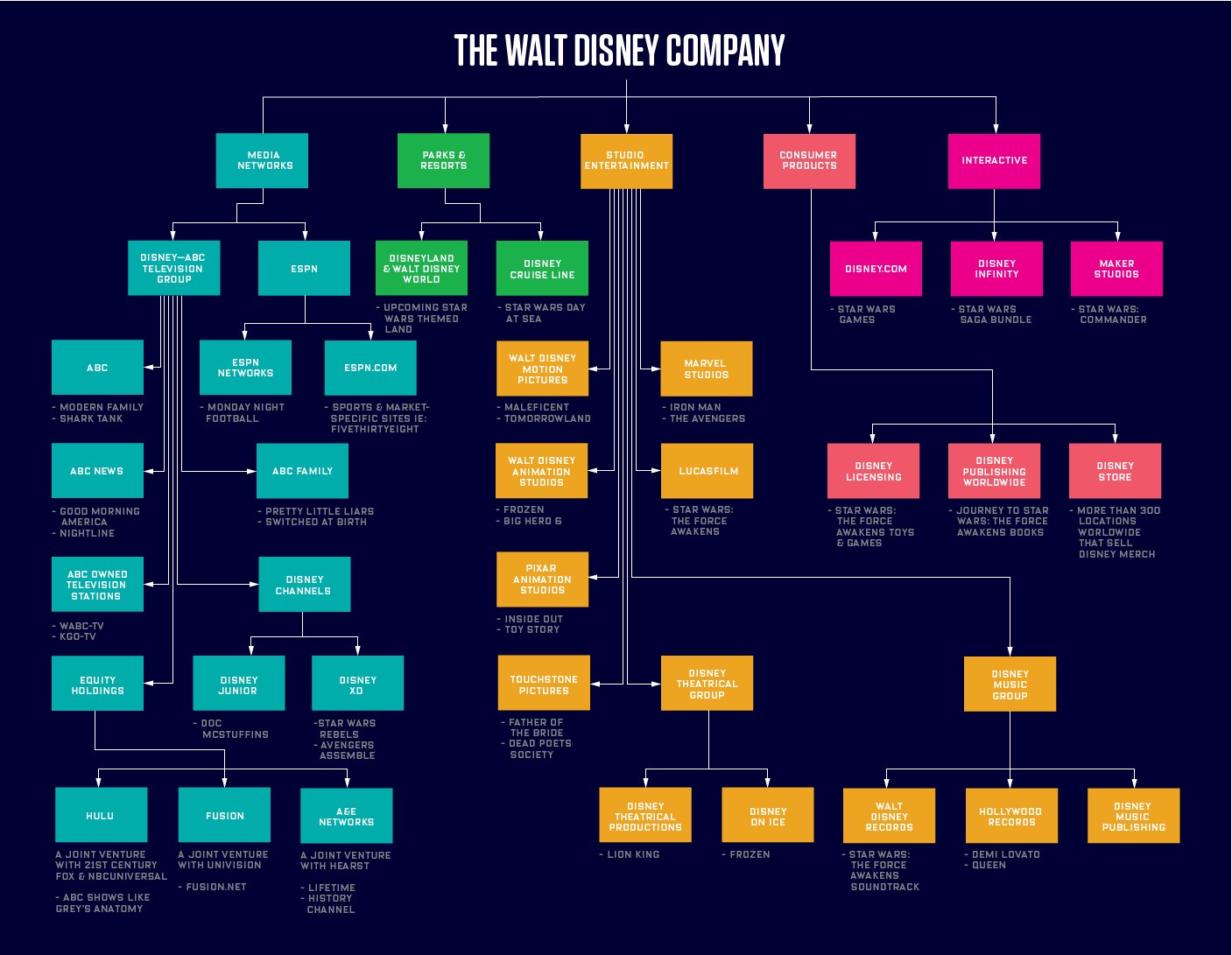
With everything that Disney owns (ABC, ESPN, Lucasfilm, A&E, Hulu, and more), it’s not hard to understand how effectively it can promote a product (a personality, toy, movie, TV show, concert) through any or all of its holdings. By plastering a specific message on all of its outlets, Disney can insure that many of us will know whatever they want us to know.
Why do you think “Good Morning America” on the ABC TV Network would broadcast “live” from Disney World, instead of its usual studio in Times Square, New York City? Why would “World News Tonight,” ABC’s primary evening newscast, air a feature on Star Wars or the latest Disney animated feature? It’s all about financial synergy.
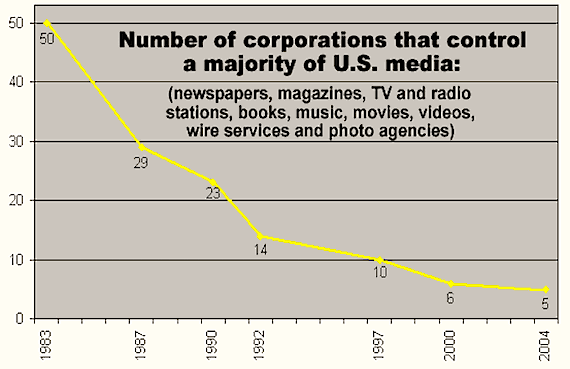
The Rise of Big Media
Take a look at the graphic above and notice what has happened to media ownership since 1983 when majority control of U.S. media was held by 50 corporations. In 2004, the number had fallen to five.
Since 2004, another giant has joined the group (Comcast), making six. If the AT&T merger is approved, we’ll see the Time Warner logo in this graphic change to a familiar white globe with blue stripes. (In late 2016, a planned merger between Viacom and CBS was called off. But there will certainly be more news about these two mega-companies in the coming year.)

A good question for students to investigate is: who are these companies and what are their major holdings? The information included in this data-rich story is a good start and the infographic, though dated, provides visual impact.
What are the ramifications/implications if only six companies control a majority of American media? One response is that there are fewer voices out there; it becomes harder to get a diversity of opinion. Another might be that the most important news increasingly gives way to the most profitable news.
Some Activities for Students
► Here’s a simple activity to engage your class. Many of them watch late-night TV, but do they know who owns those late night programs? Let them investigate and complete the final column.
► Here’s a meatier PBL activity close to home. Ask your students to investigate who owns the media in your community. Consider radio stations, newspapers, TV stations, cable companies, internet-based news; billboard companies, etc. Is there a pattern? Does one company own more than one radio station in your community: is that problematic? (Older students might review the evolution of FCC ownership rules.)
Do the media in your community cover issues and events adequately? Do your students know where their community news originates? Do they care if the news is owned/produced by someone local or some national corporation thousands of miles away?
A good example of what happens when distant media own local media outlets occurred in North Dakota. The 2002 event, an overnight toxic chemical train derailment, and the subsequent inability to get word to local residents, is documented in the book Fight for Air: The Battle To Control America’s Media. The Washington Post summarized the story:
When a train derailment in the middle of the night released a frightening cloud of anhydrous ammonia, Minot police sought to notify the citizenry of the crisis. They called KCJB, the (radio) station designated as the local emergency broadcaster, but no one was home; the station was being run by computer, automatically passing along Clear Channel programming from another city.” (Read more about this incident at Slate: “What Really Happened in Minot, N.D.?”)
► Conflicts of interest. Have students research stories about conflicts between reporters and media owners and advertisers. Then explore whether and how Big Media ownership may play a role in controlling what news reaches the public.
For example: Sometimes reporters digging deep into a story run into conflicts with their bosses. That’s exactly what happened to CBS investigative reporter Roberta Baskin. She had traveled to Vietnam to report on labor abuses at NIKE’s overseas shoe factories. (Her story and other similar ones are explored in the documentary Shadows Of Liberty.)
When CBS refused to broadcast an update of her NIKE sweatshop story, Baskin resigned, pointing to evidence that CBS based its decision on an upcoming agreement with Nike to co-sponsor the Winter Olympics.. (See Democracy Now’s account for more on this story.)
So what are the pressures on journalists trying to do their jobs? Are there stories some news organizations owned by media conglomerates won’t touch? Without question, there are. For example, during the years when NBC was owned by General Electric, the network would not broadcast news stories critical of nuclear power because its parent company, GE, owned or built many of those facilities. For more examples, students might explore Project Censored’s annual report of the least covered significant news stories.
Resources for Big Media Research
◆ Industry publications
Multichannel News
Broadcasting & Cable Magazine
Recent example: “Redstones Call Off CBS-Viacom Merger” (12/12/16)
◆ How Americans Get Their News (2016) – Pew Research Center
◆ “The FCC Scandal“ The Nation (2006)
◆ Shadows of Liberty (documentary)
◆ The Mickey Mouse Giant: The Impact the Walt Disney Company Has on ABC News (slide set by digital strategist Kate Hamilton)
◆ Mouse-ke-fear (Brill’s Content, 1998) and ABC Shelves Report on Parent Disney (New York Times, 1998)
◆ Media Ownership and Democracy in the Digital Information Age: Promoting Diversity with First Amendment Principles and Market Structure Analysis (Center for Internet & Society, Stanford Law School – a book exploring policy ideas to reduce Big Media influence)
◆ These Six Corporations Own Most of The Media (2014)
◆ Who Owns The Media? (FreePress – regularly updated)
◆ Big Money, Big Media, Big Trouble Bill Moyers
A Final Note: Stay Alert
Media ownership is constantly combining and morphing, so teachers and students need to be alert to the accuracy of any statements about who owns what at any given time.
One notable example: Internet pioneer AOL was organized in the 1990s, eventually became powerful enough to buy Time Warner in 2000, but failed to thrive and eventually was spun off by Time Warner in 2009. Over the next six years AOL strengthened with deals like the purchase of Huffington Post and partnerships with top ad-selling rivals like Yahoo and Microsoft. In 2015, AOL was purchased by Verizon. AOL chief Tim Armstrong said at the time: “If you look forward five years, you’re going to be in a space where there are going to be massive, global-scale networks, and there’s no better partner for us.” Until there is.
What continues to be clear is that giant media, internet and communications companies understand the power and profit associated with owning news and information properties that exert huge influence over consumer spending. This is the essential lesson to be learned by ourselves and our students.
Credit: Some of this material comes from my book Media Literacy in the K-12 Classroom, 2nd Edition (ISTE 2016).
Feature image: Free Press
__________
